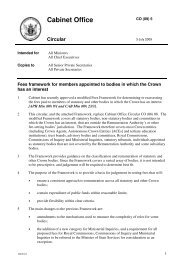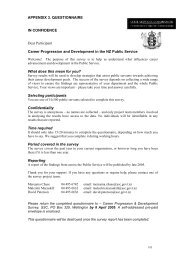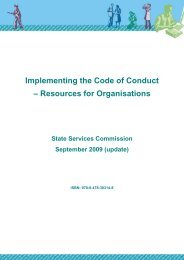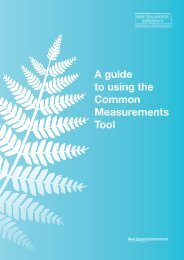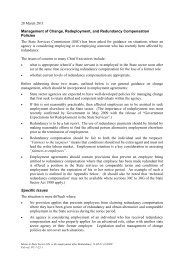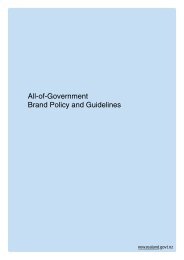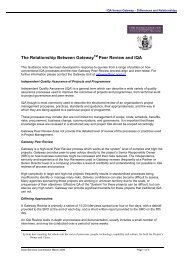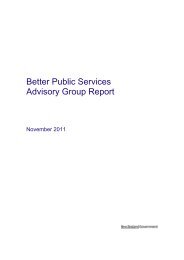Reviewing the Machinery of Government - State Services Commission
Reviewing the Machinery of Government - State Services Commission
Reviewing the Machinery of Government - State Services Commission
You also want an ePaper? Increase the reach of your titles
YUMPU automatically turns print PDFs into web optimized ePapers that Google loves.
<strong>Reviewing</strong> <strong>the</strong> <strong>Machinery</strong><br />
<strong>of</strong> <strong>Government</strong>
<strong>State</strong> <strong>Services</strong> <strong>Commission</strong><br />
PO Box 329<br />
Wellington<br />
New Zealand<br />
Ph: (04) 495 6600<br />
Fax: (04) 495 6686<br />
February 2007<br />
ISBN 978-0-478-30305-6<br />
Crown copyright reserved 2007<br />
This document is published online at www.ssc.govt.nz<br />
For fur<strong>the</strong>r information on <strong>the</strong><br />
Development Goals for <strong>the</strong> <strong>State</strong> <strong>Services</strong>, see<br />
http://www.ssc.govt.nz
Contents<br />
Introduction .................................................................................................................................. 3<br />
Meaning <strong>of</strong> “<strong>Machinery</strong> <strong>of</strong> <strong>Government</strong>” .................................................................................... 3<br />
Importance <strong>of</strong> context................................................................................................................... 3<br />
Importance <strong>of</strong> problem definition ................................................................................................4<br />
Terms <strong>of</strong> Reference ...................................................................................................................... 4<br />
Criteria.......................................................................................................................................... 4<br />
Approach to choosing organisational form .................................................................................. 5<br />
Question 1: What type <strong>of</strong> agency? ........................................................................................... 5<br />
What governance and accountability requirements?............................................................ 6<br />
What role? ........................................................................................................................ 7<br />
What functions? ............................................................................................................... 7<br />
What powers?................................................................................................................... 8<br />
What funding?.................................................................................................................. 8<br />
What risks?....................................................................................................................... 8<br />
What governance?............................................................................................................ 9<br />
Additional lens: Development Goals for <strong>the</strong> <strong>State</strong> <strong>Services</strong> ............................................ 9<br />
What organisational form has <strong>the</strong> desired governance and accountability arrangements? 11<br />
Scope .............................................................................................................................. 11<br />
Commercial functions .................................................................................................... 11<br />
Fully commercial environment .................................................................................. 11<br />
Not fully commercial environment ............................................................................ 12<br />
Non-commercial functions............................................................................................. 12<br />
High degree <strong>of</strong> Ministerial control or oversight......................................................... 13<br />
In between high degree <strong>of</strong> Ministerial control or oversight, and independence from<br />
Ministerial influence over decision making............................................................... 15<br />
Decision making independence from Ministerial influence ...................................... 16<br />
Question 2: New agency or existing agency? ........................................................................ 18<br />
New agency? ...................................................................................................................... 18<br />
If existing agency, which one?........................................................................................... 18<br />
Check list: working on machinery <strong>of</strong> government..................................................................... 18
REVIEWING THE MACHINERY OF GOVERNMENT<br />
STATE SERVICES COMMISSION 2007<br />
2
REVIEWING THE MACHINERY OF GOVERNMENT<br />
STATE SERVICES COMMISSION 2007<br />
Introduction<br />
1 This paper is written for public servants and o<strong>the</strong>r employees in <strong>the</strong> <strong>State</strong> <strong>Services</strong> who<br />
deal with machinery <strong>of</strong> government issues. It sets out <strong>the</strong> main lines <strong>of</strong> thought adopted<br />
by <strong>the</strong> <strong>State</strong> <strong>Services</strong> <strong>Commission</strong> (SSC) for machinery <strong>of</strong> government analysis,<br />
especially for determining which organisational form is best suited to carry out<br />
government functions.<br />
2 This paper is by no means a compendium covering all possible machinery <strong>of</strong> government<br />
questions or situations. It does not deal comprehensively with all aspects <strong>of</strong> analysis. Its<br />
aim is to set out <strong>the</strong> main lines <strong>of</strong> thinking that inform high quality policy advice on<br />
machinery <strong>of</strong> government issues. More detailed analysis will be required on most<br />
machinery <strong>of</strong> government issues, including consultation with <strong>the</strong> SSC and o<strong>the</strong>r agencies,<br />
especially <strong>the</strong> Treasury.<br />
Meaning <strong>of</strong> “<strong>Machinery</strong> <strong>of</strong> <strong>Government</strong>”<br />
3 <strong>Machinery</strong> is an apt metaphor for <strong>the</strong> structures and systems <strong>of</strong> government. A machine<br />
is an instrument that exists in order to fulfil a purpose beyond itself. The parts in a<br />
machine move and change, and can be replaced or improved. In this paper, <strong>the</strong> term<br />
“machinery <strong>of</strong> government” refers to:<br />
• <strong>the</strong> allocation <strong>of</strong> functions to and between departments and o<strong>the</strong>r government<br />
agencies<br />
• <strong>the</strong> creation <strong>of</strong> a new department or o<strong>the</strong>r government agency, and <strong>the</strong><br />
amalgamation or abolition <strong>of</strong> existing departments and o<strong>the</strong>r government agencies<br />
• <strong>the</strong> co-ordination <strong>of</strong> <strong>the</strong> activities <strong>of</strong> departments and o<strong>the</strong>r government agencies.<br />
4 <strong>Reviewing</strong> <strong>the</strong> machinery <strong>of</strong> government across all areas <strong>of</strong> government is one <strong>of</strong> <strong>the</strong><br />
<strong>State</strong> <strong>Services</strong> <strong>Commission</strong>er’s principal functions [<strong>State</strong> Sector Act 1988, s.6(a)].<br />
Departments dealing with policy issues that have potential implications for <strong>the</strong><br />
machinery <strong>of</strong> government are required to consult <strong>the</strong> SSC [Cabinet Office, Step by Step<br />
Guide 11.6].<br />
Importance <strong>of</strong> context<br />
5 In practice, machinery <strong>of</strong> government decision making rarely follows a scientific path<br />
that leads inexorably to a clear conclusion. As former <strong>State</strong> <strong>Services</strong> <strong>Commission</strong>er D K<br />
Hunn expressed it in 1997:<br />
“<strong>Machinery</strong> <strong>of</strong> government changes do not tend to happen merely because<br />
<strong>of</strong> <strong>the</strong> existence <strong>of</strong> an abstract set <strong>of</strong> design criteria. Context is crucial. They<br />
tend to occur in response to perceived problems or inadequacies. Criteria<br />
may have a significant affect on <strong>the</strong> ultimate design, but o<strong>the</strong>r<br />
considerations will also be relevant such as political judgements about <strong>the</strong><br />
suitability <strong>of</strong> different organisational forms, or practical considerations<br />
about <strong>the</strong> relative ease with which changes can be made”.<br />
6 For example, a political party’s pre-election campaign may include a commitment to<br />
establish a new agency to carry out a particular role. The government may have decided<br />
it wants more control over an agency, or that an agency’s objectives or functions should<br />
expand or be restricted, or that better coordination is needed between agencies without<br />
changing <strong>the</strong>ir form or functions; and so on. The advice must fit <strong>the</strong> context and nature<br />
<strong>of</strong> <strong>the</strong> issue.<br />
3
REVIEWING THE MACHINERY OF GOVERNMENT<br />
STATE SERVICES COMMISSION 2007<br />
Importance <strong>of</strong> problem definition<br />
7 It is sometimes tempting to use machinery <strong>of</strong> government changes (most notably,<br />
structural change) as a solution to all sorts <strong>of</strong> problems pertaining to government<br />
agencies. Doing so runs grave risks <strong>of</strong> not addressing <strong>the</strong> real problem and incurring <strong>the</strong><br />
costs and negative consequences <strong>of</strong> ill-advised change. Structural change should not be<br />
seen as an automatic panacea for problems or issues concerning:<br />
• agency leadership<br />
• inter-agency relationships<br />
• employment relations<br />
• agency culture<br />
• agency capability<br />
• systems problems.<br />
8 Though structural change can affect some problems in such areas, structural change<br />
should not be seen as <strong>the</strong> automatic or full solution. It is important that <strong>the</strong> real problem<br />
or issue is well analysed and articulated, so that <strong>the</strong> appropriate package <strong>of</strong> potential<br />
remedies can be devised.<br />
Terms <strong>of</strong> Reference<br />
9 Terms <strong>of</strong> reference (ToR) should be prepared for any significant review or exercise with<br />
implications for <strong>the</strong> machinery <strong>of</strong> government. There is no prescribed format for <strong>the</strong><br />
ToR. Key elements should include:<br />
• context: description <strong>of</strong> <strong>the</strong> situation and <strong>the</strong> issues or problems to be addressed<br />
• objective: <strong>the</strong> purpose <strong>of</strong> <strong>the</strong> review<br />
• scope/assumptions: range <strong>of</strong> issues and/or agencies covered; elements explicitly<br />
included; elements explicitly excluded, if any; constraints, if any; how <strong>the</strong> review<br />
will be conducted<br />
• deliverables<br />
• consultation<br />
• timeframe.<br />
Criteria<br />
10 Criteria should be developed as part <strong>of</strong> <strong>the</strong> review process. Sometimes, it is appropriate<br />
to include <strong>the</strong> criteria in <strong>the</strong> ToR. The criteria should:<br />
• take account <strong>of</strong> <strong>the</strong> sectoral context<br />
• address <strong>the</strong> particular issues or problems<br />
• encapsulate <strong>the</strong> desired state or level <strong>of</strong> performance (NB this does not mean preempting<br />
<strong>the</strong> outcome <strong>of</strong> <strong>the</strong> review).<br />
4
11 For example, relevant factors may include:<br />
REVIEWING THE MACHINERY OF GOVERNMENT<br />
STATE SERVICES COMMISSION 2007<br />
• with regard to context, whe<strong>the</strong>r <strong>the</strong> government has modified its objectives for an<br />
activity; whe<strong>the</strong>r o<strong>the</strong>r players have emerged with substantially similar roles;<br />
whe<strong>the</strong>r international agreements or o<strong>the</strong>r developments call for a change in <strong>the</strong><br />
way a certain activity is carried out<br />
• with regard to <strong>the</strong> desired state or level <strong>of</strong> performance, whe<strong>the</strong>r structural change<br />
or a reallocation <strong>of</strong> functions would better achieve <strong>the</strong> government’s desired<br />
outcomes through, for example, improved capability, efficiency, coordination;<br />
improved clarity <strong>of</strong> roles and responsibilities and better governance; improved<br />
responsiveness to government policy; better information flows; improved risk<br />
management; reduced compliance costs; and so on.<br />
12 A strategic review <strong>of</strong> a government agency should be undertaken at regular intervals, for<br />
example, when preparing <strong>the</strong> position description for a new departmental chief executive<br />
or new chairperson <strong>of</strong> a Crown entity board. The review should consider, among o<strong>the</strong>r<br />
things, whe<strong>the</strong>r all <strong>of</strong> <strong>the</strong> existing agency’s functions should continue to be provided by<br />
<strong>the</strong> agency (e.g. whe<strong>the</strong>r <strong>the</strong>re is a statutory or government policy imperative that <strong>the</strong>y<br />
continue). This includes assessing:<br />
• what functions are ‘must do’, ‘should do’, ‘could do’, ‘could cease doing’?<br />
• what would happen if a particular function were to cease?<br />
• what o<strong>the</strong>r agencies might be more suitable for taking on a particular function?<br />
• is <strong>the</strong>re something different that <strong>the</strong> agency should take on?<br />
Approach to choosing organisational form<br />
13 Within <strong>the</strong> contextual reality, high quality analysis is important for <strong>the</strong> provision <strong>of</strong> free<br />
and frank, comprehensive advice to Ministers on <strong>the</strong> machinery <strong>of</strong> government. If <strong>the</strong><br />
issue or problem involves reassessing or determining what agency in <strong>the</strong> <strong>State</strong> sector<br />
should be charged with certain functions, two main questions need to be answered:<br />
• Question 1: What type <strong>of</strong> agency?<br />
As shown on <strong>the</strong> contents page <strong>of</strong> this paper, a series <strong>of</strong> sub-questions underpins <strong>the</strong><br />
analysis required to answer this question. The questions aim to build a picture <strong>of</strong> an<br />
agency’s overall ‘pr<strong>of</strong>ile’ in terms <strong>of</strong> <strong>the</strong> desirable governance and accountability regime,<br />
so that <strong>the</strong> most appropriate organisational form can <strong>the</strong>n be identified.<br />
• Question 2: Existing agency, or new agency?<br />
Question 1: What type <strong>of</strong> agency?<br />
14 The analysis required to answer this question - what type <strong>of</strong> agency? – aims at clarifying<br />
two main issues:<br />
• What are <strong>the</strong> desirable governance and accountability arrangements?<br />
• What organisational form corresponds best with <strong>the</strong> desired governance and<br />
accountability regime?<br />
5
REVIEWING THE MACHINERY OF GOVERNMENT<br />
STATE SERVICES COMMISSION 2007<br />
What governance and accountability requirements?<br />
15 Once <strong>the</strong> desirable governance and accountability arrangements are clear, <strong>the</strong> main<br />
organisational options follow suit.<br />
Hence, while at a high level <strong>the</strong> axiom “form follows function” is correct:<br />
• “form follows function and governance” is more accurate; and<br />
• “form is based on governance <strong>of</strong> functions and powers” is even more accurate.<br />
16 “Form follows function” locates <strong>the</strong> right ‘ball park’ at a high level, but it is not always<br />
sufficient. For example:<br />
• purely judicial functions belong in <strong>the</strong> judicial branch <strong>of</strong> government<br />
• quasi-parliamentary functions belong in <strong>the</strong> legislative branch <strong>of</strong> government. But,<br />
does <strong>the</strong> function belong in an Office <strong>of</strong> Parliament or o<strong>the</strong>r agency that supports<br />
<strong>the</strong> House?<br />
• commercial functions <strong>of</strong> executive government belong in an agency with<br />
commercial objectives. But, should <strong>the</strong> agency (a company) be a <strong>State</strong>-owned<br />
enterprise, or Crown entity company, or o<strong>the</strong>r form <strong>of</strong> company?<br />
• non-commercial functions <strong>of</strong> executive government belong in one <strong>of</strong> <strong>the</strong> many<br />
o<strong>the</strong>r types <strong>of</strong> agencies in <strong>the</strong> executive branch <strong>of</strong> government. But, should <strong>the</strong><br />
agency be a department or one <strong>of</strong> <strong>the</strong> types <strong>of</strong> Crown entities or o<strong>the</strong>r form <strong>of</strong><br />
agency?<br />
17 Well-informed judgements about organisational choice cannot jump from a general idea<br />
about an organisational role to a clear-cut decision on <strong>the</strong> most appropriate organisational<br />
form. “We know what we want this organisation to do” should not lead directly to<br />
addressing “so, what are <strong>the</strong> organisational choices?”<br />
18 High quality policy advice relies on additional information. There are certain questions<br />
that should always be asked, within <strong>the</strong> contextual reality.<br />
<strong>Machinery</strong> <strong>of</strong> <strong>Government</strong>: The Big Questions<br />
Qu. 1<br />
Qu. 2<br />
Qu. 3<br />
Qu. 4<br />
Qu. 5<br />
Qu. 6<br />
What role?<br />
• for central government?<br />
• for <strong>the</strong> agency in <strong>the</strong> context <strong>of</strong> who else it needs to work with?<br />
• for <strong>the</strong> agency as a stand alone entity?<br />
What functions?<br />
• to carry out role?<br />
What powers?<br />
• to carry out functions?<br />
What funding?<br />
• what source(s)?<br />
• how ‘materially significant’?<br />
What risks?<br />
• from functions and powers?<br />
• strategic, political, fiscal or contractual risk?<br />
What governance?<br />
• what Ministerial involvement?<br />
6
REVIEWING THE MACHINERY OF GOVERNMENT<br />
STATE SERVICES COMMISSION 2007<br />
Qu. 1:<br />
What role?<br />
19 For central government - Generally, machinery <strong>of</strong> government analysis proceeds on <strong>the</strong><br />
basis that government is already involved in an area <strong>of</strong> activity, or has decided as a<br />
matter <strong>of</strong> policy to become involved in that activity, and that government’s involvement<br />
requires it to discharge functions through ownership or control <strong>of</strong> one or more<br />
organisations.<br />
20 There are times when it is legitimate to step back and first consider whe<strong>the</strong>r <strong>the</strong><br />
involvement <strong>of</strong> central government is necessary or desirable, especially if local<br />
authorities, non-government agencies or individuals already carry out <strong>the</strong> same role or a<br />
very similar role. In such cases, what is <strong>the</strong> need or justification for central government<br />
involvement?<br />
21 For <strong>the</strong> agency in <strong>the</strong> context <strong>of</strong> who it needs to work with - The majority <strong>of</strong> agencies in<br />
<strong>the</strong> <strong>State</strong> sector must, by virtue <strong>of</strong> <strong>the</strong>ir role and objectives, collaborate with o<strong>the</strong>r<br />
agencies or co-ordinate <strong>the</strong>ir activities in some way or o<strong>the</strong>r. The nature <strong>of</strong> <strong>the</strong><br />
collaboration required influences <strong>the</strong> appropriate governance arrangements, which in turn<br />
are critical to <strong>the</strong> choice <strong>of</strong> organisational form. For example, basic sharing <strong>of</strong><br />
information from time to time is not <strong>the</strong> same as a formal, on-going commitment <strong>of</strong><br />
agency resources to work on a joint strategy or programme alongside partner agencies,<br />
and where <strong>the</strong> level and type <strong>of</strong> collaboration is critical to combined and individual<br />
success.<br />
22 For <strong>the</strong> agency as a stand alone entity - The first step towards determining <strong>the</strong> most<br />
appropriate organisational form <strong>of</strong> a stand alone government-owned or controlled agency<br />
is to identify its role. At <strong>the</strong> highest level this can sometimes indicate which branch <strong>of</strong><br />
government should carry out <strong>the</strong> role, although more detailed criteria are <strong>of</strong>ten necessary<br />
also.<br />
23 Within <strong>the</strong> executive branch <strong>of</strong> government, <strong>the</strong> role <strong>of</strong> government agencies can be<br />
considered generally under broad headings such as advisory, service delivery, regulatory,<br />
quasi-judicial, purchase or funding, trading, or financial institution. Certain agencies<br />
carry out a mix <strong>of</strong> roles. This high level categorisation <strong>of</strong> an agency’s primary role or<br />
roles is clearly insufficient on its own to lead to a decision about <strong>the</strong> most suitable<br />
organisational form for carrying out <strong>the</strong> agency’s activities. For example, a regulatory<br />
role may be discharged by a department or different types <strong>of</strong> Crown entities. More<br />
detailed information is needed to discern between <strong>the</strong> organisational design options.<br />
Qu. 2:<br />
What functions?<br />
24 In addition to knowing what an agency’s overall role will be, a more detailed<br />
understanding is required <strong>of</strong> what <strong>the</strong> agency will actually do, i.e. its actual functions or<br />
day-to-day activities. For example, if a regulatory body is under consideration, will its<br />
functions include issuing licences to operate? This understanding starts to build a picture<br />
<strong>of</strong> an agency’s pr<strong>of</strong>ile in terms <strong>of</strong> <strong>the</strong> nature and scope <strong>of</strong> its activities, <strong>the</strong> impact <strong>of</strong> its<br />
7
REVIEWING THE MACHINERY OF GOVERNMENT<br />
STATE SERVICES COMMISSION 2007<br />
functions, <strong>the</strong> variety <strong>of</strong> stakeholders, <strong>the</strong> sensitivities around ensuring that <strong>the</strong> activities<br />
are carried out appropriately, and <strong>the</strong> nature <strong>of</strong> risks if things go wrong.<br />
Qu. 3:<br />
What powers?<br />
25 Many agencies in <strong>the</strong> <strong>State</strong> sector are endowed with specific powers to enable <strong>the</strong>m to<br />
discharge <strong>the</strong>ir functions. For example, a regulatory body that has <strong>the</strong> power to issue a<br />
licence to operate <strong>of</strong>ten has <strong>the</strong> power to suspend or revoke <strong>the</strong> licence if <strong>the</strong> operator<br />
fails in some way to observe <strong>the</strong> licence conditions. A clear understanding <strong>of</strong> <strong>the</strong> nature<br />
and scope <strong>of</strong> an agency’s powers is a vital component <strong>of</strong> an agency’s ‘pr<strong>of</strong>ile’. <strong>State</strong><br />
sector governance and organisational form have a great deal to do with <strong>the</strong> public powers<br />
entrusted to an agency.<br />
Qu. 4:<br />
What funding?<br />
26 An agency’s pr<strong>of</strong>ile includes its funding arrangements, from at least three perspectives:<br />
• source(s) – Crown, levy, trading, or mix?<br />
• quantity – significant, especially from a Crown perspective, or not substantial?<br />
• sustainability – what are <strong>the</strong> longer term intentions for on-going funding? Are <strong>the</strong>re<br />
risks to sustainability?<br />
27 Ano<strong>the</strong>r relevant funding question is what should happen to an agency’s funds and<br />
liabilities if <strong>the</strong> agency is wound up e.g. should <strong>the</strong>y revert to <strong>the</strong> Crown? The Treasury<br />
should be included in <strong>the</strong> deliberations.<br />
Qu. 5:<br />
What risks?<br />
28 An understanding <strong>of</strong> <strong>the</strong> risks associated with <strong>the</strong> agency’s functions and powers is also<br />
necessary. The key types <strong>of</strong> risk that are pertinent are:<br />
• strategic risk – <strong>the</strong> strategic relevance to <strong>the</strong> government and society <strong>of</strong> <strong>the</strong><br />
activity, and <strong>the</strong> associated risks if something adverse happens<br />
• political risk – <strong>the</strong> level <strong>of</strong> expectation that <strong>the</strong> Minister and <strong>the</strong> <strong>Government</strong> will<br />
be held responsible if things go wrong; in <strong>the</strong> end, this is always a matter for<br />
Ministers to decide<br />
• fiscal risk – <strong>the</strong> potential for monetary loss<br />
• contractual risk - whe<strong>the</strong>r or not <strong>the</strong> agency’s activities are readily ‘contractible’<br />
i.e. some activities are not readily contractible because <strong>the</strong> objectives or outputs are<br />
complex, inherently difficult to specify or measure, or may need to be changed<br />
frequently.<br />
29 Legal risks are also important. For example, are <strong>the</strong> proposed functions consistent with<br />
relevant legislation or common law? What checks and balances might be needed when<br />
determining <strong>the</strong> most appropriate organisational form to perform <strong>the</strong> functions?<br />
30 Risks are generally viewed in terms <strong>of</strong> likelihood and potential impact. For machinery <strong>of</strong><br />
government purposes, it is necessary to assess whe<strong>the</strong>r an activity poses a high level <strong>of</strong><br />
risk from <strong>the</strong> Minister’s and <strong>the</strong> <strong>Government</strong>’s perspective.<br />
8
REVIEWING THE MACHINERY OF GOVERNMENT<br />
STATE SERVICES COMMISSION 2007<br />
31 This question is directly relevant to <strong>the</strong> governance and accountability arrangements that<br />
should exist between <strong>the</strong> Minister and <strong>the</strong> agency.<br />
Qu. 6:<br />
What governance?<br />
On <strong>the</strong> basis <strong>of</strong> <strong>the</strong> ‘pr<strong>of</strong>ile’ that emerges in response to <strong>the</strong> previous questions, what type <strong>of</strong><br />
governance arrangements should apply? This question is posed first from <strong>the</strong> perspective <strong>of</strong><br />
<strong>the</strong> <strong>Government</strong> and <strong>the</strong> responsible Minister.<br />
32 With regard to <strong>the</strong> myriad <strong>of</strong> non-commercial agencies that operate as part <strong>of</strong> <strong>the</strong><br />
executive branch <strong>of</strong> government, <strong>the</strong> essential question is whe<strong>the</strong>r <strong>the</strong> Minister should:<br />
• have a high degree <strong>of</strong> control or oversight?<br />
• have a degree <strong>of</strong> control or oversight in-between high level and being clearly<br />
separated from decision making?<br />
• be clearly separated from decision making, where <strong>the</strong> decision maker is<br />
independent from Ministerial influence?<br />
33 For each level <strong>of</strong> Ministerial involvement, <strong>the</strong>re is an associated ‘package’ <strong>of</strong> governance<br />
arrangements that determine <strong>the</strong> feasible organisational design options.<br />
Additional lens: Development Goals for <strong>the</strong> <strong>State</strong> <strong>Services</strong><br />
34 In March 2005, <strong>the</strong> <strong>Government</strong> agreed an ambitious set <strong>of</strong> Development Goals for <strong>the</strong><br />
<strong>State</strong> <strong>Services</strong>. The Development Goals are “aspirations for how <strong>the</strong> <strong>State</strong> <strong>Services</strong> will<br />
be arranged and perform” 1 . As such, <strong>the</strong> goals provide an additional lens for machinery<br />
<strong>of</strong> government analysis and advice.<br />
Overall Goal<br />
A system <strong>of</strong> world class pr<strong>of</strong>essional <strong>State</strong> <strong>Services</strong> serving <strong>the</strong> government <strong>of</strong> <strong>the</strong> day and<br />
meeting <strong>the</strong> needs <strong>of</strong> New Zealanders<br />
Development Goals<br />
Employer <strong>of</strong> Choice – Ensure <strong>the</strong> <strong>State</strong> <strong>Services</strong> is an employer <strong>of</strong> choice attractive to high<br />
achievers with a commitment to service<br />
Excellent <strong>State</strong> Servants – Develop a strong culture <strong>of</strong> constant learning in <strong>the</strong> pursuit <strong>of</strong><br />
excellence<br />
Networked <strong>State</strong> <strong>Services</strong> – Use technology to transform <strong>the</strong> provision <strong>of</strong> services for New<br />
Zealanders<br />
Coordinated <strong>State</strong> Agencies – Ensure <strong>the</strong> total contribution <strong>of</strong> government agencies is greater<br />
than <strong>the</strong> sum <strong>of</strong> its parts<br />
Accessible <strong>State</strong> <strong>Services</strong> – Enhance access, responsiveness and effectiveness, and improve<br />
New Zealanders’ experience <strong>of</strong> <strong>State</strong> <strong>Services</strong><br />
Trusted <strong>State</strong> <strong>Services</strong> – Streng<strong>the</strong>n trust in <strong>the</strong> <strong>State</strong> <strong>Services</strong>, and reinforce <strong>the</strong> spirit <strong>of</strong><br />
service<br />
35 On <strong>the</strong>ir own <strong>the</strong> goals do not provide answers to many machinery <strong>of</strong> government<br />
questions, but <strong>the</strong> goals should always be referred to when preparing machinery <strong>of</strong><br />
government advice. Advisors should be able to explain in what ways <strong>the</strong>ir policy<br />
proposals would help to achieve one or more <strong>of</strong> <strong>the</strong> goals.<br />
1<br />
Development Goals for <strong>the</strong> <strong>State</strong> <strong>Services</strong>, SSC brochure, March 2005<br />
9
Figure 1: Main Organisational Design Options<br />
Functions<br />
outside Executive<br />
Branch<br />
(for reasons <strong>of</strong><br />
separation<br />
<strong>of</strong> powers)<br />
Purely judicial functions Judicial Branch Court, Tribunal or Authority<br />
Functions that<br />
support Parliament<br />
Legislative Branch<br />
check on Executive Branch’s<br />
use <strong>of</strong> power/resources<br />
internal support<br />
Office <strong>of</strong> Parliament<br />
Parliamentary Service; Office <strong>of</strong> <strong>the</strong> Clerk<br />
Full commercial environment (while exhibiting sense <strong>of</strong> social responsibility)<br />
<strong>State</strong>-Owned Enterprise<br />
Commercial<br />
functions<br />
Not full commercial<br />
environment;<br />
or mixed objectives<br />
Default:<br />
wholly owned by <strong>the</strong> Crown & full accountability regime<br />
Unless:<br />
majority/wholly Crown owned & lighter accountability regime<br />
Crown entity company<br />
PFA 4 th Sch. company<br />
High degree <strong>of</strong><br />
Ministerial control<br />
or oversight<br />
Ministerial power to<br />
direct agency to give<br />
effect to govt policy<br />
Default:<br />
close relationship with Minister<br />
Unless:<br />
arms length from Minister<br />
Department<br />
Crown Agent<br />
Functions<br />
inside Executive<br />
Branch<br />
Non<br />
commercial<br />
functions<br />
In between high<br />
degree <strong>of</strong> Ministerial<br />
control or oversight,<br />
and independence<br />
from Ministerial<br />
influence over<br />
decision making<br />
Default:<br />
Ministerial power to direct<br />
agency to have regard to<br />
govt policy<br />
Unless:<br />
light-handed<br />
Ministerial role<br />
full governance &<br />
accountability regime<br />
lighter governance &<br />
accountability regime<br />
Autonomous Crown<br />
Entity (ACE)<br />
PFA 4 th Sch. trust or statutory<br />
board, council or corporation<br />
Function requires<br />
decision maker to be<br />
independent from<br />
Ministerial influence<br />
(for reasons <strong>of</strong> public<br />
confidence)<br />
Default:<br />
decision maker must be, and be<br />
seen to be, independent<br />
Unless:<br />
absolute public confidence is paramount (requires<br />
decision maker to be protected against easy dismissal,<br />
& not required to give effect/have regard to govt policy)<br />
‘Statutorily independent function’ (SIF) in<br />
Dept or Agent or ACE or Crown entity company<br />
Independent Crown<br />
Entity (ICE)
What organisational form has <strong>the</strong> desired governance and accountability<br />
arrangements?<br />
Scope<br />
36 The diagram on <strong>the</strong> previous page [Figure 1: Main Organisational Design Options]<br />
provides a quick overview <strong>of</strong> <strong>the</strong> main organisational forms across <strong>the</strong> three branches <strong>of</strong><br />
government: judicial branch, legislative branch and executive branch.<br />
37 This paper does not discuss fur<strong>the</strong>r:<br />
• <strong>the</strong> judicial branch <strong>of</strong> government<br />
• <strong>the</strong> legislative branch <strong>of</strong> government<br />
• specific agencies or types <strong>of</strong> agencies in <strong>the</strong> executive branch <strong>of</strong> government:<br />
- <strong>the</strong> Reserve Bank <strong>of</strong> New Zealand (<strong>the</strong> only agency <strong>of</strong> its kind in <strong>the</strong> <strong>State</strong><br />
<strong>Services</strong>)<br />
- School Boards <strong>of</strong> Trustees and Tertiary Education Institutions (distinct types<br />
<strong>of</strong> educational bodies with comprehensive sets <strong>of</strong> provisions respectively in<br />
<strong>the</strong> Education Act 1989)<br />
- Crown entity subsidiary companies (which are formed or acquired by one or<br />
more parent Crown entities in accordance with provisions in <strong>the</strong> Crown<br />
Entities Act 2004)<br />
- less commonly used organisational forms that tend to carry out specific or<br />
relatively small roles, such as Ministerial advisory committees, statutory<br />
commissions or councils, foundations and similar bodies.<br />
38 This paper focuses on <strong>the</strong> remaining bulk <strong>of</strong> agencies in <strong>the</strong> <strong>State</strong> <strong>Services</strong>, plus <strong>State</strong>owned<br />
enterprises.<br />
Commercial functions<br />
39 The basic principle is that commercial activities <strong>of</strong> <strong>the</strong> government should be carried out<br />
by agencies with commercial objectives.<br />
Fully commercial environment<br />
40 A function should be deemed a ‘commercial function’ and undertaken by a <strong>State</strong>-owned<br />
enterprise (SOE) if:<br />
• performance is measured primarily in financial terms; and<br />
• revenue is generated through <strong>the</strong> sale <strong>of</strong> goods and services.<br />
41 SOEs have unambiguous commercial objectives, and <strong>the</strong> Crown’s objectives are<br />
relatively straightforward – being to maximise <strong>the</strong> return to <strong>the</strong> shareholding Ministers<br />
over time. SOEs are designed to operate as an efficient and pr<strong>of</strong>itable business. They<br />
tend to sell into contestable markets (although monopoly enterprises exist).<br />
42 Never<strong>the</strong>less, an SOE is required to exhibit a sense <strong>of</strong> social responsibility by having<br />
regard to <strong>the</strong> interests <strong>of</strong> <strong>the</strong> community in which it operates and by endeavouring to<br />
accommodate or encourage <strong>the</strong>se when able to do so.
REVIEWING THE MACHINERY OF GOVERNMENT<br />
STATE SERVICES COMMISSION 2007<br />
43 The SOE Act recognises that an SOE may have non-commercial roles, but requires<br />
Ministers to enter into an agreement with <strong>the</strong> agency to pay for any goods or services that<br />
<strong>the</strong>y wish an SOE to provide to any person.<br />
Not fully commercial environment<br />
44 A quasi-commercial form <strong>of</strong> statutory governance should be used (i.e. a Crown entity<br />
company or a company listed on <strong>the</strong> 4 th Schedule <strong>of</strong> <strong>the</strong> Public Finance Act) if:<br />
• <strong>the</strong> context or environment in which a function is to be undertaken is not fully<br />
commercial; or<br />
• <strong>the</strong> agency undertaking a function has mixed objectives.<br />
45 Non-SOE companies are generally established by <strong>the</strong> Crown to fur<strong>the</strong>r certain policy<br />
objectives (e.g. Crown Research Institutes, Television New Zealand Ltd) and a pr<strong>of</strong>it<br />
objective may be secondary.<br />
Crown entity company<br />
46 Crown entity companies are incorporated under <strong>the</strong> Companies Act 1993 and are one <strong>of</strong><br />
<strong>the</strong> five categories <strong>of</strong> Crown entity defined in s.7 <strong>of</strong> <strong>the</strong> Crown Entities Act 2004. This<br />
Act applies in addition to <strong>the</strong> Companies Act, and contains comprehensive provisions<br />
about <strong>the</strong>ir establishment and governance, operation, reporting and financial obligations.<br />
47 Crown entity companies are wholly owned by <strong>the</strong> Crown (i.e. shares may be held only by<br />
two or more Ministers).<br />
48 Apart from a reconstruction or merger in which <strong>the</strong> Crown’s shareholding is not<br />
diminished, legislation is required to enable any transfer <strong>of</strong> ownership (legislation may<br />
also be required in <strong>the</strong> case <strong>of</strong> a merger, where <strong>the</strong> Crown entity company has been<br />
established by an Act). Incremental transfer <strong>of</strong> ownership is not possible, as <strong>the</strong> shares in<br />
a Crown entity company may be held only by Ministers (i.e. <strong>the</strong> Ministers cannot<br />
progressively reduce <strong>the</strong>ir shareholding to less than 100%).<br />
Company listed on <strong>the</strong> 4 th Schedule <strong>of</strong> <strong>the</strong> Public Finance Act<br />
49 There are circumstances where <strong>the</strong> Crown may wish to establish a non-SOE company,<br />
but it is not appropriate to establish it as a Crown entity company:<br />
• joint ownership is necessary or desirable i.e. <strong>the</strong> Crown intends to reduce its<br />
shareholding at some stage to somewhere between over 50% and under 100%; or<br />
• ‘materiality’ or ‘distinctiveness’ reasons indicate that a Crown entity company is<br />
not feasible or appropriate. The Crown may wish to establish an agency to fulfil a<br />
specific policy objective for which <strong>the</strong> legal form <strong>of</strong> a company is <strong>the</strong> most suitable<br />
organisational choice, but for which <strong>the</strong> full governance and accountability regime<br />
applying to a ‘standard’ Crown entity company would not be appropriate.<br />
Incorporating a company under <strong>the</strong> Companies Act 1993 and adding it to <strong>the</strong> 4 th<br />
Schedule <strong>of</strong> <strong>the</strong> PFA by Order in Council is a way to meet both objectives.<br />
Non-commercial functions<br />
50 The Guidelines on Process and Content <strong>of</strong> Legislation published by <strong>the</strong> Legislation<br />
Advisory Committee explains that: “There is a continuum <strong>of</strong> bodies exercising public<br />
power at <strong>the</strong> level <strong>of</strong> central government. At one end is <strong>the</strong> standard Minister-department<br />
relationship and along it various forms <strong>of</strong> independent or partly independent power. The<br />
legal structures should reflect that continuum and <strong>the</strong> reasons for greater or lesser<br />
autonomy”.<br />
12
REVIEWING THE MACHINERY OF GOVERNMENT<br />
STATE SERVICES COMMISSION 2007<br />
51 Non-commercial functions <strong>of</strong> central government agencies can be placed under three<br />
broad headings along <strong>the</strong> continuum <strong>of</strong> bodies exercising public power:<br />
• high degree <strong>of</strong> ministerial control or oversight<br />
• in between high degree <strong>of</strong> Ministerial control or oversight, and independence from<br />
Ministerial influence over decision making<br />
• function requires decision maker to be independent from Ministerial influence.<br />
High degree <strong>of</strong> Ministerial control or oversight<br />
At <strong>the</strong> ‘high end’ <strong>of</strong> <strong>the</strong> continuum are those functions and powers for which it is<br />
desirable or necessary to have a high degree <strong>of</strong> Ministerial oversight or control.<br />
This level <strong>of</strong> Ministerial involvement is characterised by a governance relationship<br />
where <strong>the</strong> responsible Minister has <strong>the</strong> power to direct <strong>the</strong> agency to give effect to <strong>the</strong><br />
policy <strong>of</strong> <strong>the</strong> government <strong>of</strong> <strong>the</strong> day.<br />
52 The organisational design options that meet this fundamental governance criterion are:<br />
Department<br />
• departments; and<br />
• <strong>the</strong> type <strong>of</strong> statutory Crown entity known as Crown agents (such as <strong>the</strong> Accident<br />
Compensation Corporation, District Health Boards and Land Transport New<br />
Zealand).<br />
53 Departments are legally part <strong>of</strong> <strong>the</strong> Crown (i.e. <strong>the</strong>y do not have separate corporate<br />
status; <strong>the</strong>y exercise powers and legally contract in <strong>the</strong> name <strong>of</strong> <strong>the</strong> Crown).<br />
54 There is a close and hierarchical relationship between Ministers and departments, with<br />
<strong>the</strong> governance arrangements centred on a direct Minister-chief executive relationship.<br />
Ministers have extensive powers to direct departments, as long as such directions are<br />
consistent with <strong>the</strong> law (e.g. <strong>the</strong>re are relatively numerous statutory requirements for<br />
<strong>of</strong>ficials to act independently in some matters – which can be quite significant).<br />
55 The types <strong>of</strong> functions and powers that require a high degree <strong>of</strong> Ministerial control or<br />
oversight, and for which departments are <strong>the</strong> default choice <strong>of</strong> organisational form<br />
include:<br />
• <strong>the</strong> activities in some sense are an inherent function <strong>of</strong> <strong>the</strong> <strong>State</strong> (e.g. <strong>the</strong> conduct <strong>of</strong><br />
foreign policy; national defence)<br />
• <strong>the</strong> agency will exercise significant coercive powers <strong>of</strong> <strong>the</strong> <strong>State</strong> (e.g. policing;<br />
prisons; tax collection)<br />
• o<strong>the</strong>r special powers will reside in <strong>the</strong> agency or its <strong>of</strong>ficials (e.g. <strong>the</strong> substantial<br />
powers <strong>of</strong> <strong>the</strong> Director-General <strong>of</strong> <strong>the</strong> Ministry <strong>of</strong> Agriculture and Forestry under<br />
<strong>the</strong> Animal Products Act 1999)<br />
• <strong>the</strong> agency will provide policy advice to government<br />
• <strong>the</strong> agency will carry out multiple functions, particularly where <strong>the</strong> functions<br />
potentially conflict<br />
13
REVIEWING THE MACHINERY OF GOVERNMENT<br />
STATE SERVICES COMMISSION 2007<br />
• <strong>the</strong> complexity <strong>of</strong> <strong>the</strong> activities makes it difficult to “contract” for <strong>the</strong>ir provision<br />
by a Crown entity (if, for example, <strong>the</strong> objectives or outputs are complex,<br />
inherently difficult to specify or measure, or may need to be changed frequently)<br />
• constitutional conventions indicate a need for close Ministerial oversight or direct<br />
Ministerial responsibility (e.g. citizenship); or<br />
• <strong>the</strong>re is a Ministerial desire to control <strong>the</strong> process and outcome <strong>of</strong> an activity,<br />
including frequently reviewing its objectives. This may be indicated by:<br />
- <strong>the</strong> significance and importance <strong>of</strong> <strong>the</strong> activity to <strong>the</strong> government<br />
- <strong>the</strong> high public and political expectations associated with <strong>the</strong> activity; or<br />
- <strong>the</strong> nature <strong>of</strong> <strong>the</strong> risks posed to <strong>the</strong> Crown (e.g. strategic or fiscal risks).<br />
Crown Agent<br />
56 Crown agents are one <strong>of</strong> <strong>the</strong> three types <strong>of</strong> statutory Crown entities, as defined in s.7 <strong>of</strong><br />
<strong>the</strong> Crown Entities Act 2004. Every Crown agent:<br />
• is a stand alone body corporate: it is a legal entity separate from <strong>the</strong> Crown, its<br />
board members, <strong>of</strong>fice holders and employees<br />
• has <strong>the</strong> power – subject to law - to do anything that a natural person <strong>of</strong> full age and<br />
capacity may do e.g. own property and enter into contracts in its own name<br />
• is subject to its enabling legislation and <strong>the</strong> Crown Entities Act 2004.<br />
57 The legal separation from <strong>the</strong> Crown establishes an ‘arms length’ distance between <strong>the</strong><br />
Minister and <strong>the</strong> entity. The channels <strong>of</strong> Ministerial direction or instruction are<br />
considerably more formalised than <strong>the</strong> interactions between a Minister and department.<br />
The governance arrangements are centred on <strong>the</strong> Minister-board relationship.<br />
58 Placing a function in a Crown agent ra<strong>the</strong>r than in a department is justifiable in three<br />
circumstances:<br />
• it is essential to access certain skills and experience that can only be provided by<br />
members <strong>of</strong> a governance board; OR<br />
• positioning outside <strong>the</strong> legal Crown is critical to success (e.g. because <strong>the</strong><br />
government itself may be bound by <strong>the</strong> decisions); OR<br />
• a degree <strong>of</strong> separation from Ministers in <strong>the</strong> allocation <strong>of</strong> Crown resources and<br />
delegation <strong>of</strong> a significant degree <strong>of</strong> decision making authority to <strong>the</strong> entity is<br />
needed to:<br />
- credibly distance Ministers from politically hard/sensitive decisions,<br />
including those involving individuals; and/or<br />
- limit <strong>the</strong> scope for Ministers to become involved in decision making.<br />
59 Certain regulatory bodies and devolved purchaser/funding agencies are likely to satisfy<br />
one or o<strong>the</strong>r <strong>of</strong> <strong>the</strong>se criteria, as do certain significant service delivery agencies that<br />
require <strong>the</strong> skills and experience <strong>of</strong> a governance board.<br />
14
REVIEWING THE MACHINERY OF GOVERNMENT<br />
STATE SERVICES COMMISSION 2007<br />
In between high degree <strong>of</strong> Ministerial control or oversight, and independence from Ministerial<br />
influence over decision making<br />
Towards <strong>the</strong> middle <strong>of</strong> <strong>the</strong> continuum are those functions and powers that do not require<br />
a high degree <strong>of</strong> Ministerial control or oversight.<br />
This level <strong>of</strong> Ministerial involvement is characterised:<br />
• normally, by a governance relationship where <strong>the</strong> responsible Minister has <strong>the</strong><br />
power to direct <strong>the</strong> agency to have regard to <strong>the</strong> policy <strong>of</strong> <strong>the</strong> government <strong>of</strong> <strong>the</strong><br />
day; or<br />
• in some circumstances, by a relationship where <strong>the</strong> responsible Minister has a<br />
light-handed role.<br />
60 The organisational design options that fit <strong>the</strong>se governance criteria are:<br />
• <strong>the</strong> autonomous Crown entity (ACE) type <strong>of</strong> statutory Crown entity; and<br />
• an agency listed on <strong>the</strong> 4 th Schedule <strong>of</strong> <strong>the</strong> Public Finance Act.<br />
Autonomous Crown entity (ACE)<br />
61 Just like Crown agents, every ACE is a stand alone legal entity separate from <strong>the</strong> Crown.<br />
They are established as bodies corporate. They are also subject to <strong>the</strong>ir own enabling<br />
statute as well as comprehensive provisions for governance, operations and<br />
accountability in <strong>the</strong> Crown Entities Act 2004.<br />
62 ACEs are suitable for carrying out non-commercial executive government functions that:<br />
• are substantial in <strong>the</strong>ir own right and are designed to meet identified policy<br />
objectives (e.g. significant service delivery agencies); and<br />
• will be sustainable in financial and policy terms to warrant <strong>the</strong> establishment <strong>of</strong> a<br />
body corporate that is legally separate from <strong>the</strong> Crown (as opposed to meeting a<br />
specific or short term need that could be met by a temporary body or an existing<br />
agency);<br />
• should come under <strong>the</strong> management skills and experience <strong>of</strong> a governance board;<br />
• do not:<br />
- constitute inherent functions <strong>of</strong> <strong>the</strong> <strong>State</strong>, such as national security; or<br />
- involve <strong>the</strong> exercise <strong>of</strong> significant coercive powers, such as policing; or<br />
- pose significant strategic or fiscal risks for <strong>the</strong> Crown, or political risks that<br />
should come under closer Ministerial control.<br />
Agency listed on <strong>the</strong> 4 th Schedule <strong>of</strong> <strong>the</strong> Public Finance Act<br />
63 There can be ‘materiality’ or ‘distinctiveness’ circumstances where it would not be<br />
appropriate to apply all <strong>the</strong> governance, accountability and reporting provisions in <strong>the</strong><br />
Crown Entities Act 2004 to an agency whose functions and powers do not require a high<br />
degree <strong>of</strong> Ministerial control or oversight. For example:<br />
• an agency’s operations are small (including in financial terms) or local in nature<br />
(e.g. Reserves Boards; Fish and Game Councils), or<br />
15
REVIEWING THE MACHINERY OF GOVERNMENT<br />
STATE SERVICES COMMISSION 2007<br />
• an agency operates within a different legal framework (e.g. those agencies that are<br />
trusts, such as <strong>the</strong> Road Safety Trust), or<br />
• an agency has certain features that do not mesh with <strong>the</strong> requirements in <strong>the</strong> Crown<br />
Entities Act 2004. For example, whereas statutory Crown entities are bodies<br />
corporate (including corporations sole), <strong>the</strong> New Zealand Lottery Grants Board is<br />
not a body corporate and it has a board <strong>of</strong> which half <strong>of</strong> <strong>the</strong> members are required<br />
to be Members <strong>of</strong> Parliament (two Ministers <strong>of</strong> <strong>the</strong> Crown and <strong>the</strong> Leader <strong>of</strong> <strong>the</strong><br />
Opposition).<br />
64 Listing an agency on <strong>the</strong> 4 th Schedule <strong>of</strong> <strong>the</strong> Public Finance Act:<br />
• ensures, by virtue <strong>of</strong> s.45M(1) <strong>of</strong> <strong>the</strong> PFA, that minimum provisions in <strong>the</strong> Crown<br />
Entities Act 2004 apply (notably <strong>the</strong> Ministerial power to request information and<br />
<strong>the</strong> obligation to prepare annual financial statements, a statement <strong>of</strong> responsibility<br />
and audit report); and<br />
• provides discretion, by virtue <strong>of</strong> s.45N(1) <strong>of</strong> <strong>the</strong> PFA, to apply a specific range <strong>of</strong><br />
additional requirements in <strong>the</strong> Crown Entities Act (such as <strong>the</strong> requirement for an<br />
annual statement <strong>of</strong> intent, annual report, and certain financial restrictions).<br />
65 It is important when preparing advice about a prospective PFA 4 th Schedule agency to be<br />
satisfied that <strong>the</strong> test <strong>of</strong> ‘materiality’ or ‘distinctiveness’ is real i.e. <strong>the</strong>re are clearly<br />
identifiable reasons why a Crown entity would not be suitable.<br />
Decision making independence from Ministerial influence<br />
At <strong>the</strong> o<strong>the</strong>r end <strong>of</strong> <strong>the</strong> continuum are decision making functions that, for reasons <strong>of</strong><br />
public confidence, should be made independently from Ministerial influence.<br />
The governance relationship and organisational form depend on both:<br />
• <strong>the</strong> degree <strong>of</strong> separation required for reasons <strong>of</strong> public confidence; and<br />
• <strong>the</strong> agency’s role, functions and powers considered collectively.<br />
66 The governance and organisational design options that protect <strong>the</strong> independence <strong>of</strong><br />
decision making from Ministerial influence, where necessary for reasons <strong>of</strong> public<br />
confidence, are:<br />
• a ‘statutorily independent function’ located in a department or Crown agent or<br />
autonomous Crown entity or Crown entity company; or<br />
• <strong>the</strong> type <strong>of</strong> statutory Crown entity known as an independent Crown entity (ICE).<br />
Statutorily independent function<br />
67 If public confidence requires decision making to be, and to be seen to be, free from<br />
Ministerial influence, <strong>the</strong> default solution is to:<br />
• place <strong>the</strong> function in <strong>the</strong> appropriate type <strong>of</strong> agency (department or Crown agent or<br />
autonomous Crown entity or Crown entity company) having regard to:<br />
- <strong>the</strong> agency’s role, functions and powers considered collectively; and<br />
- <strong>the</strong> criteria discussed earlier in this paper with regard to each <strong>of</strong> <strong>the</strong>se<br />
organisational design options; and<br />
16
REVIEWING THE MACHINERY OF GOVERNMENT<br />
STATE SERVICES COMMISSION 2007<br />
• specify in legislation that <strong>the</strong> particular function or functions must be carried out<br />
free from Ministerial influence: this will establish a function as a ‘statutorily<br />
independent function’ (SIF).<br />
68 Establishing agencies with some statutorily independent functions is relatively common<br />
across <strong>the</strong> <strong>State</strong> <strong>Services</strong>. The following table illustrates <strong>the</strong> point.<br />
Department<br />
(e.g. Statistics New<br />
Zealand)<br />
Crown Agent<br />
(e.g. Sport and<br />
Recreation New<br />
Zealand)<br />
Autonomous<br />
Crown entity<br />
(e.g. Te Papa)<br />
Crown entity<br />
company<br />
(e.g. TVNZ)<br />
Ministerial influence …<br />
Close relationship, and extensive<br />
powers <strong>of</strong> direction: Statistics NZ’s role<br />
is <strong>of</strong> very high strategic importance for all<br />
areas <strong>of</strong> central government policy<br />
Arms length relationship, but power to<br />
direct to give effect to government<br />
policy: e.g. in relation to national policies<br />
and strategies for physical recreation and<br />
sport<br />
Arms length relationship, but power to<br />
direct to have regard to government<br />
policy: e.g. in relation to maintaining and<br />
controlling <strong>the</strong> Museum<br />
Power to direct on content <strong>of</strong><br />
statement <strong>of</strong> intent:<br />
e.g. in relation to performance measures<br />
against TVNZ’s charter<br />
… but also independent<br />
decision making<br />
Decisions relating to<br />
statistical methods and<br />
publication <strong>of</strong> statistics<br />
Decisions to allocate funds<br />
to, or for <strong>the</strong> benefit <strong>of</strong>, any<br />
persons<br />
Decisions relating to<br />
individual exhibitions<br />
Decisions relating to<br />
particular programmes or<br />
news items<br />
69 The examples in <strong>the</strong> table illustrate that it is possible to meet <strong>the</strong> twin objectives <strong>of</strong>:<br />
• safeguarding <strong>the</strong> need for independence from Ministerial influence with regard to<br />
particular decision making functions; and<br />
• placing those functions in an agency that is required o<strong>the</strong>rwise (because <strong>of</strong> its<br />
overall role and o<strong>the</strong>r functions and powers), to be subject to some degree <strong>of</strong><br />
Ministerial influence or control.<br />
Independent Crown entity<br />
70 An independent Crown entity (ICE) is appropriate in cases where public confidence in<br />
decision making is paramount, such that it demands a level <strong>of</strong> independence from<br />
Ministers for decision making purposes that can be provided only where <strong>the</strong> decision<br />
maker is:<br />
• NEITHER subject to influence or easy removal by Ministers<br />
• NOR required to give effect or have regard to <strong>the</strong> policies <strong>of</strong> <strong>the</strong> government <strong>of</strong> <strong>the</strong><br />
day.<br />
71 Absolute public confidence is likely to be needed where significant coercive powers are<br />
exercised by <strong>the</strong> entity, its decisions are binding, and <strong>the</strong> Crown is subject to its<br />
jurisdiction.<br />
72 Typically, quasi-judicial and adjudicative functions (e.g. those <strong>of</strong> <strong>the</strong> Police Complaints<br />
Authority and <strong>the</strong> Commerce <strong>Commission</strong>), as well as certain investigative roles (e.g.<br />
those <strong>of</strong> <strong>the</strong> Transport Accident Investigation <strong>Commission</strong> and <strong>the</strong> New Zealand Sports<br />
Drug Agency) and regulatory activities (such as <strong>of</strong> <strong>the</strong> Accounting Standards Review<br />
Board) meet <strong>the</strong>se criteria. It is appropriate that <strong>the</strong>y are constituted as ICEs.<br />
17
REVIEWING THE MACHINERY OF GOVERNMENT<br />
STATE SERVICES COMMISSION 2007<br />
Question 2: New agency or existing agency?<br />
73 After identifying what type <strong>of</strong> agency should carry out a particular role, <strong>the</strong> next question<br />
is whe<strong>the</strong>r, in order to achieve <strong>the</strong> <strong>Government</strong>’s objectives, it is sufficient and suitable<br />
to allocate <strong>the</strong> functions and powers to an existing agency in <strong>the</strong> <strong>State</strong> sector, or whe<strong>the</strong>r<br />
it is necessary to establish a stand alone agency.<br />
74 An assessment <strong>of</strong> <strong>the</strong> New Zealand public management system carried out in 2001<br />
identified a need to address fragmentation as one <strong>of</strong> <strong>the</strong> three main areas for attention,<br />
including re-examining <strong>the</strong> large number <strong>of</strong> agencies 2 . Against this backdrop, a<br />
convincing case must be established in order for a new agency to be justified.<br />
New agency?<br />
75 A new agency should be considered only if:<br />
• a proposed role or function is incompatible with any existing agency e.g. <strong>the</strong>re are<br />
strategic or operational reasons why no existing agency should carry out <strong>the</strong><br />
proposed role and associated functions; AND<br />
• it would not be feasible or appropriate to expand <strong>the</strong> role or functions <strong>of</strong> an existing<br />
agency; AND<br />
• all <strong>the</strong> necessary capability and financial viability could be guaranteed for <strong>the</strong><br />
present and long term; AND<br />
• <strong>the</strong> establishment <strong>of</strong> a new agency could be justified in cost-benefit terms.<br />
If existing agency, which one?<br />
76 If it is determined that an existing agency should be charged with a particular role, ei<strong>the</strong>r<br />
because <strong>the</strong> government wants a new role to be performed or as <strong>the</strong> result <strong>of</strong> a merger,<br />
<strong>the</strong> criteria for choosing which agency should include, at a minimum:<br />
• ‘fit for purpose’: compatibility with <strong>the</strong> existing agency’s present role and<br />
functions; and<br />
• capability: whe<strong>the</strong>r <strong>the</strong> agency has, or could acquire, what it would need now and<br />
in <strong>the</strong> future to deliver <strong>the</strong> interventions and outputs which best contribute to <strong>the</strong><br />
outcomes government is seeking; and<br />
• whe<strong>the</strong>r <strong>the</strong> merger or expansion would be cost effective without jeopardising <strong>the</strong><br />
efficient, effective and economical management <strong>of</strong> <strong>the</strong> activities <strong>of</strong> <strong>the</strong> host agency<br />
or <strong>the</strong> activities that are to transfer.<br />
Check list: working on machinery <strong>of</strong> government<br />
77 Advisors working on machinery <strong>of</strong> government matters, especially proposals that could<br />
lead to change in any <strong>of</strong> <strong>the</strong> areas mentioned in paragraph 3, as well as managers<br />
responsible for implementing change, should check to ensure <strong>the</strong> following steps.<br />
2<br />
Report <strong>of</strong> <strong>the</strong> Advisory Group on <strong>the</strong> Review <strong>of</strong> <strong>the</strong> Centre, presented to <strong>the</strong> Ministers <strong>of</strong> <strong>State</strong> <strong>Services</strong> and Finance,<br />
November 2001.<br />
18
REVIEWING THE MACHINERY OF GOVERNMENT<br />
STATE SERVICES COMMISSION 2007<br />
Policy development phase<br />
<strong>Commission</strong>ing <strong>the</strong> work<br />
- Who requested/directed <strong>the</strong> work to be done e.g. <strong>the</strong> Minister, chief executive, board<br />
chairperson? Clarify that person’s expectations regarding <strong>the</strong> ToR, including sign-<strong>of</strong>f<br />
- Ensure <strong>the</strong>re is agreement on <strong>the</strong> situation/issue/problem to be addressed. Depending on<br />
<strong>the</strong> review, <strong>the</strong> ‘problem statement’ may be explicit in <strong>the</strong> ToR, or clarified as part <strong>of</strong> <strong>the</strong><br />
review process<br />
- Who will carry out <strong>the</strong> analysis and write <strong>the</strong> report(s) e.g. will <strong>the</strong> work be done in-house,<br />
or does an inter-agency working group need to be convened, or will a third party be<br />
contracted to carry out <strong>the</strong> review (with in-house support)? For any contracted work,<br />
ensure <strong>the</strong> process complies with applicable procurement rules and guidelines<br />
- Departments must consult SSC and should involve SSC and Treasury early in <strong>the</strong><br />
development phase. Consider who else will need to be consulted during <strong>the</strong> review<br />
- Clarify with <strong>the</strong> project sponsor <strong>the</strong> reporting milestones and timeframe<br />
- Finalise ToR. Ensure it covers at least all <strong>the</strong> elements in paragraph 9<br />
Analysis phase<br />
- Adhere to what is in scope, and be conscious <strong>of</strong> what is out <strong>of</strong> scope, as per ToR<br />
- In line with <strong>the</strong> project objective and problem definition, consider <strong>the</strong> full range <strong>of</strong> potential<br />
solutions i.e. do not leap straight to structural change as a universal or sole remedy<br />
- Ensure genuine consultation i.e. listen seriously and objectively to <strong>the</strong> views expressed,<br />
with an open mind to changing one’s initial position as a result. But this does not create an<br />
obligation to satisfy all views expressed by modifying <strong>the</strong> report and recommendations in<br />
an attempt to please all submitters<br />
Reporting phase<br />
- Be aware <strong>of</strong> realistic timeframes, especially if papers are to go through <strong>the</strong> Cabinet<br />
process and legislative change would be required to implement <strong>the</strong> recommendations<br />
Implementation phase<br />
Change management plan<br />
- The change leader should prepare a change management plan for every machinery <strong>of</strong><br />
government change. The plan should include: context for <strong>the</strong> change process; key<br />
organisational issues; workstreams, phases and milestones; governance for <strong>the</strong> change<br />
process; risk analysis; monitoring <strong>of</strong> progress; evaluation<br />
Statutory requirements<br />
- The <strong>State</strong> Sector Act provides for <strong>the</strong> transfer <strong>of</strong> functions between departments and for<br />
<strong>the</strong> merger <strong>of</strong> departments. Sections 30A to 30L provide for such things as <strong>the</strong> transfer <strong>of</strong><br />
staff, <strong>the</strong> disestablishment <strong>of</strong> existing departments, consequential amendments to o<strong>the</strong>r<br />
legislation, and <strong>the</strong> continuity <strong>of</strong> legal proceedings<br />
- Specific legislation is likely to be required when a Crown entity is disestablished and when<br />
<strong>the</strong> transfer <strong>of</strong> functions is from a department to a Crown entity<br />
- Records must not be disposed <strong>of</strong> without <strong>the</strong> Chief Archivist’s authorisation. Records<br />
relating to a function which has been transferred to ano<strong>the</strong>r government agency may be<br />
transferred: <strong>the</strong> Chief Archivist must be notified within 3 months <strong>of</strong> <strong>the</strong> transfer<br />
- Check all applicable employment agreements, both individual and collective, and be<br />
aware <strong>of</strong> <strong>the</strong>ir implications. The Employment Relations Act now requires all agreements to<br />
have clauses relating to transfer <strong>of</strong> employees<br />
- Legislation is required to preserve Crown appointments and statutory <strong>of</strong>ficers where <strong>the</strong>se<br />
are affected by machinery <strong>of</strong> government change<br />
- Be aware <strong>of</strong> any statutory functions to be affected by machinery <strong>of</strong> government change –<br />
especially if proposed legislation has not been enacted. This means having a transitional<br />
plan to ensure <strong>the</strong> appropriate discharge <strong>of</strong> functions continues<br />
- If a new agency should be subject to <strong>the</strong> Ombudsmen Act 1975 and <strong>the</strong> Official<br />
Information Act 1982, it needs to be listed in <strong>the</strong> respective schedules in <strong>the</strong>se Acts<br />
- Ensure that responsibilities and accountabilities are maintained with <strong>the</strong> appropriate<br />
person/agency as requirements fall due, and that <strong>the</strong>re is a formal point or points for <strong>the</strong><br />
handover <strong>of</strong> responsibility e.g. for <strong>the</strong> Annual Report, <strong>State</strong>ment <strong>of</strong> Intent, etc<br />
19







